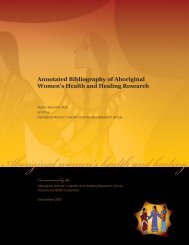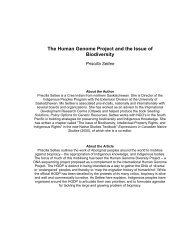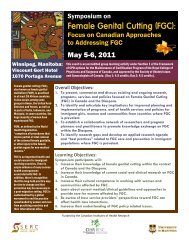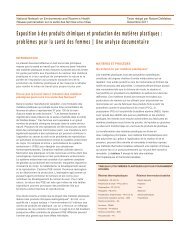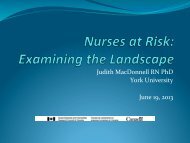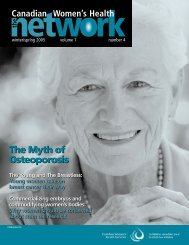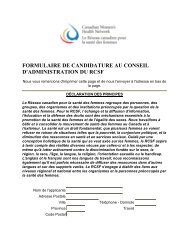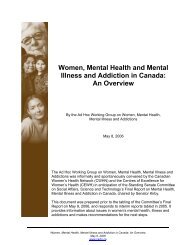here. - Canadian Women's Health Network
here. - Canadian Women's Health Network
here. - Canadian Women's Health Network
- No tags were found...
You also want an ePaper? Increase the reach of your titles
YUMPU automatically turns print PDFs into web optimized ePapers that Google loves.
TABLE 4AVERAGE INCOMES – ABORIGINAL AND ALL CANADIANSAVERAGE INCOME, 1995Male Female Gender GapAboriginal People $18,221.00 $13,305.00 26.90%All <strong>Canadian</strong>s $31,117.00 $19,208.00 38.3%SOURCE: 1996 Census – Statistics Canada 94F0009XDB96001Women, Income and<strong>Health</strong> in Manitoba14These data clearly show that Aboriginalwomen have higher poverty rates thaneither Aboriginal men or Non-Aboriginalwomen or men. Their average incomesare lower than those of Aboriginal men,or all <strong>Canadian</strong>s. The average income ofAboriginal women in Canada in 1995was $17,812 lower than the averageincome of <strong>Canadian</strong> men. Put anotherway, for every dollar earned by Aboriginalwomen, <strong>Canadian</strong> men earned $2.34.These data are important to keep in mindwhen considering issues of income andhealth. Firstly, poverty among Aboriginalpeople is gendered, as it is among the<strong>Canadian</strong> population as a whole. Secondly,these lower income levels are a contributingfactor to the poor health status of Aboriginalwomen in Canada (see 5.3 below).The combined effects of racism and sexismare clearly evident in the income levels ofAboriginal women. Examining these issuesconsidering only Aboriginal status(and not gender), or gender (and notAboriginal status), will mask the truesituation of Aboriginal women. Thecombined effects of racism and sexismare clearly evident in the income levelsof Aboriginal women.Aboriginal people face additional barriers inthe labour market. As Michael Mendelsonand Ken Battle have noted:The labour market prospects facingAboriginal <strong>Canadian</strong>s are muchworse than for other <strong>Canadian</strong>s.Many Aboriginal people are unlikelyto find consistent employment in theirlifetime. The potential costs of highunemployment extend beyond thesocial sp<strong>here</strong>. The economic futureof a region is greatly diminished whena growing percentage of its workforceis unemployed. The threat to economicwell-being is especially grave for thePrairies. T<strong>here</strong> is probably no singlemore important issue for theeconomic future of the Prairies,particularly Manitoba andSaskatchewan, than theadvancement of its Aboriginalhuman resources. 14 (emphasis added)2.4 ABORIGINAL WOMEN -KEY INFORMANT INTERVIEWSAs part of the data collection process forthis paper, interviews were held with keyinformants to discuss the connectionsbetween income and health forAboriginal women.Seven Aboriginal women participated inthese interviews. They were selectedbecause of their experience working inthe health care system, health researchexperience, and/or knowledge of Aboriginalwomen’s health. The interviews wereconducted by Angela Busch, an Aboriginal




